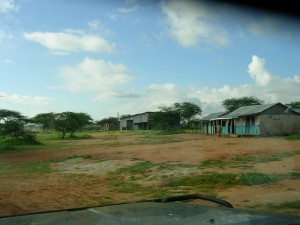Ndonyo Wasin
Two Towns: The Modern & The Bush
There are two villages in this area of the Samburu district: Sereolipi and Ndonyo Wasin. Sereolipi is small town and the Samburu call Ndonyo Wasin “bush village” Sereolipi became more developed in the mid-1970s, when a bridge was built over a mostly dried and silted riverbed, allowing trucks carry supplies to other villages farther north and up. First it was a truck stop. Around this a village grew.
Approximately 800 families live here, adding up to about 5,000 residents. The vast majority of residents live in a Samburu “manyatta“ (encampment) and keep their livestock (goats and cattle and recently camels) in pens they construct from thorn tree bushes. The most affluent members of the community, three or four families, live in cement houses.
It is hard to see Sereolipi as the modern town that the Samburu describe. The largest institution in town, ten times over, is the school. After that, there is a tiny Christian church (leftovers from the missionary push), little to no electricity outside of the school, no access to running water, no phone lines, approximately 4 shops selling basic provisions, one bar (and extension of someone’s living room) and many warriors is full regalia making their way up and down the dusty paths.
Ndonyo Wasin is the “other” Samburu town and is located exactly a marathon (26 miles) deeper into the mountains, on a path that loosely resembles a road. To my untrained eye it looks and functions much the same as Sereolipi. The residents live in manyattas and keep their livestock with thorn trees. However, Ndonyo Wasin is certainly more remote and often residents traveling into Sereolipi leave at 4 AM, to avoid the midday heat. They travel in packs and speak or sing loudly to one another, so as not be a surprise presence to elephants and lions.



Leave a Reply
You must be logged in to post a comment.